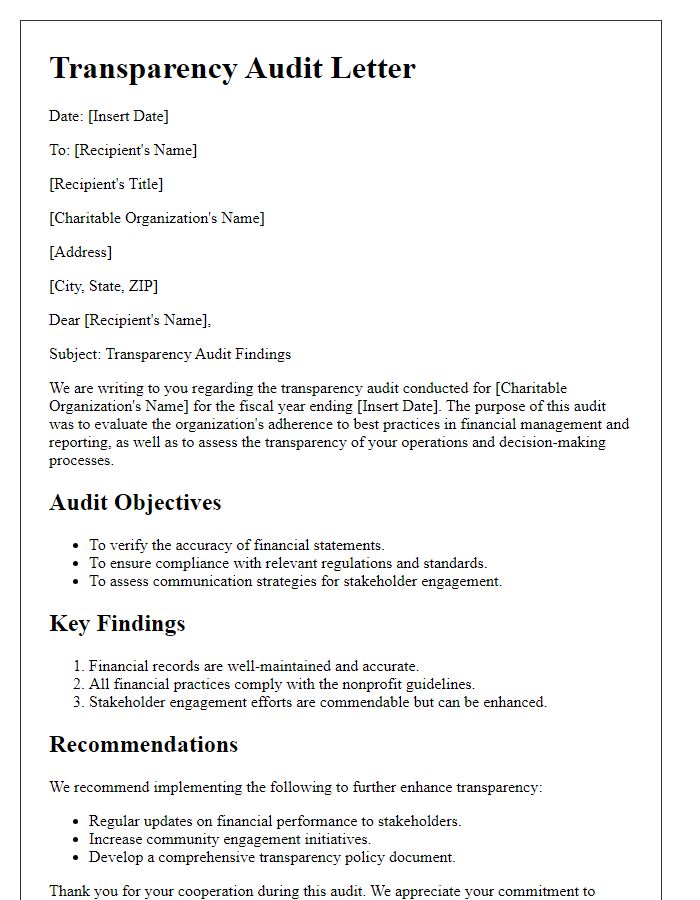Welcome to our guide on crafting a letter template for your charitable foundation's audit needs! In today's complex financial landscape, ensuring transparency and accountability is crucial for gaining the trust of your donors and community. This letter template will help you effectively communicate important information about your foundation's finances and auditing process, making it easier for stakeholders to understand your commitment to ethical practices. Ready to dive in and create a clear, professional letter? Let's explore how to structure your communication effectively!

Introduction and Purpose
The primary objective of the audit for charitable foundations, such as nonprofit organizations established to support various social causes, is to evaluate the financial integrity and compliance with regulatory requirements. This rigorous assessment ensures transparency in financial reporting, safeguarding donor trust, and adherence to the guidelines set forth by the IRS (Internal Revenue Service) under 501(c)(3) status. By examining financial statements, donor contributions, and operational expenses, auditors identify potential discrepancies or areas for improvement, ensuring the foundation's resources are effectively utilized to fulfill its mission. Ultimately, this audit process serves to enhance accountability and promote sustainable practices within the philanthropic sector, reinforcing stakeholder confidence in the foundation's commitment to ethical stewardship.
Audit Scope and Objectives
The audit of the charitable foundation focuses on assessing financial statements for the fiscal year ending December 31, 2023. Key objectives include determining compliance with GAAP (Generally Accepted Accounting Principles) for accurate reporting of assets, liabilities, and net assets. Evaluation of revenue streams, including donations and grants, will ensure proper recognition and allocation. Review of expenditures, especially program-related costs versus administrative expenses, aims to enhance transparency and evaluate operational efficiency. Risk assessment will analyze internal controls to safeguard against misappropriation of funds and ensure adherence to regulatory requirements, including IRS guidelines for 501(c)(3) organizations. The audit will culminate in a comprehensive report outlining findings, discrepancies, and recommendations for improved financial governance.
Financial Statement Overview
In this financial statement overview, the charitable foundation (Foundation Name) provides an analysis of the fiscal year ending December 31, 2022. Revenues totaled $2.5 million, driven primarily by donations from individuals and corporate sponsors, contributing $1.8 million and $500,000 respectively. Expenses amounted to $2 million, with program services receiving the largest allocation of $1.5 million, reflecting the foundation's commitment to community development and support initiatives. Administrative and fundraising expenses were $300,000 and $200,000 respectively, indicating a 15% reduction in overhead costs compared to the previous year. Total net assets reached $1.2 million, with a cash reserve of $800,000, providing a robust buffer for future initiatives. Furthermore, the foundation achieved a return on investments of 5%, showcasing effective asset management strategies. This financial overview signifies a sustainable and transparent approach to resource allocation, reinforcing the foundation's mission to create positive societal impacts.
Compliance with Regulations
A charitable foundation's compliance with regulations is essential for maintaining operational integrity and public trust. Non-profit organizations such as 501(c)(3) entities must adhere to federal guidelines established by the Internal Revenue Service (IRS) regarding financial reporting and transparency. Annual Form 990 (Return of Organization Exempt from Income Tax) submissions are required, providing detailed financial data that includes revenue, expenses, and executive compensation. State-level regulations, such as those enforced by the Attorney General's office, mandate additional disclosures and fundraising registration, ensuring that charitable contributions are used appropriately. Furthermore, adherence to the Sarbanes-Oxley Act provisions requires the establishment of auditing procedures and whistleblower protections, adding layers of governance aimed at preventing fraud and mismanagement. Regular internal audits, in conjunction with external review by certified public accountants, can help ensure compliance with these complex regulations, fostering accountability and enhancing the foundation's credibility within the community it serves.
Recommendations and Action Plan
Charitable foundations play a crucial role in community support. Audit findings may highlight the need for improved financial management practices, focusing on transparency and accountability. Notable recommendations include implementing rigorous internal controls to prevent misallocation of funds, establishing a clear budget framework for project funding, and conducting regular training for staff on compliance regulations outlined by the Internal Revenue Service (IRS) to uphold tax-exempt status. An action plan could involve the introduction of quarterly financial reporting schedules, fostering collaboration with an external auditor such as a CPA firm, and utilizing nonprofit management software for better tracking of donations and expenditures. Strengthening these areas can contribute to the overall efficacy of charitable programs, ensuring resources reach intended beneficiaries.













Comments